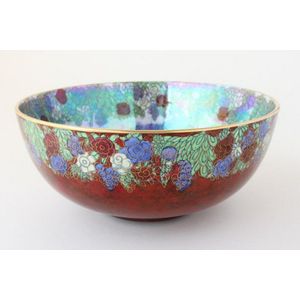Gilded Satsuma Floral Bowl
You must be a subscriber, and be logged in to view price and dealer details.
Subscribe Now to view actual auction price for this item
When you subscribe, you have the option of setting the currency in which to display prices to $Au, $US, $NZ or Stg.
- Gilding - Gilding is a method of ornamentation whereby a thin sheet of gold metal is applied to items made of wood, leather, ceramics, glass and silver for decorative purposes.
For furniture including mirrors, the sheet of gold is usually applied over a coating of gesso. Gesso is a mixture of plaster of Paris and gypsum mixed with water and then applied to the carved wooden frames of mirrors and picture frames as a base for applying the gold leaf. After numerous coats of gesso have been applied, allowed to dry and then sanded a coat of "bole", a usually red coloured mixture of clay and glue is brushed on and allowed to dry, after which the gold leaf is applied. Over time parts of the gilding will rub off so the base colour can be seen. In water gilding, this was generally a blue colour, while in oil gilding, the under layer was often yellow. In Victorian times, gilders frequently used red as a pigment beneath the gold leaf.
Metal was often gilded by a process known as fire gilding. Gold mixed with mercury was applied and heated, causing the mercury to evaporate, the long-term effect of which was to kill or disable the craftsman or woman from mercury poisoning. The pursuit of beauty has claimed many victims, not the least of which were the artists who made those pieces so highly sought after today. - Cartouche - An ornamental panel in the form of of a shield, oval or rectangular scroll with curling edges. It may be carved into the back of a chair or the top of a sideboard, or present on a piece of silver or jewellery, and contain the initials of the original owner, heraldic symbols, or some other inscription, such as the details of a presentation.
In ceramics the term defines the central area of a vase or similar with a decorative border in one of the shapes above, into which a decorative scene or figures have been painted.
This item has been included into following indexes:
Visually similar items

Satsuma bowl finely painted depicting a family within an interior setting also painted with butterflies & flowers within decorative panels to the upper section of the interior, with a continuous floral decoration to the outer bowl. Signed to base Shuzan. C

Large 19th century Cantonese punch bowl, enamelled and painted with panels of long-tailed birds, butterflies and further insects amongst blossoming sprays and fruits, all surrounded by scrolling design. Diameter 41.5 cm

An Edwardian silver bangle, sterling silver, made as a small oval shaped bangle with wide 24 mm wide top profile, engraved with four foliate panels each with scalloped surround work, plain polished finish to reverse, fitted with clasp. Inner width 58 mm

Carlton Ware bowl, of circular form, with deep sides, the interior decorated with a scene of bridge and garden in lustre tones of green, purple and red, with a rouge exterior, diameter 21.5 cm
